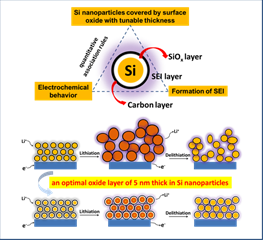Interfacial oxidation control strategy improves the properties of Si/C composite anode materials
Recently, Prof. Yong Yang's research group and Prof. Ting Zhu from Georgia Institute of Technology have made important progress in regulating the properties of Si/C nanocomposite anode materials for lithium-ion batteries by interfacial oxidation. "Controlling Surface Oxides in Si/C Nanocomposite Anodes for high-performance Li-ion Batteries" was published in Journal of Advanced Energy Mater., 2018, DOI: 10.1002/aenm.201801718.

The SiC nanocomposite electrode was prepared by quantitative control of the thickness of the oxide layer on the surface of the nano silicon spheres, and then by PAN coating pyrolysis and carbonization. It was found that when the oxide layer on the surface of the silicon nanoparticles reached the optimal thickness, the Si@SiOx/C nanocomposite anode had both high capacity and cycling stability. The regulation mechanism of interfacial oxidation on the electrochemical performance of SiC nanocomposite cathode was systematically investigated by using a variety of spectroelectrochemical experiments and chemical-mechanical model simulation. This work deeply analyzed the influence of silicon surface oxidation degree on the electrochemical performance of Si/C nanocomposite electrode, which has important guiding significance for the design of high-performance Si/C composite electrode.
Professor Yong Yang 's research group has long been committed to the basic research of electrode materials for lithium-ion batteries, and has made a series of important progress in the modification, electrochemical reaction mechanism and mechanical response of silicon anode materials for lithium-ion batteries. For example, the research group collaborated with Profs. Meilin Liu and Ting Zhu from Georgia Institute of Technology to design and synthesize a self-supporting silicon/germanium double-shell composite silicon anode material (Cu/Si/Ge NWS), and for the first time observed the co-lithiation/co-delithiation kinetic process at the Si/Ge interface. Its unique co-lithiation/co-delithiation mechanism can significantly improve the electrochemical performance of Cu/Si/Ge NWS electrode (Energy Environ. Recently, in collaboration with Prof. Chen Song Yan of the Department of Physics at Xiamen University, we have successfully induced the corrosion of boron doped micron-size silicon powder by non-precious metal copper. The porous silicon powder treated by nitrite (Si-N, Alon) has the first Coulomb efficiency of > 92% and the area specific capacity of 3 mAh cm-2 (J. Mater. Chem. A, 2018, 6, 7449). The research work is our grade 2016 doctoral Guorui Zheng, Yuxuan Xiang, materials department of xiamen university's zhangqiao bao, an assistant professor in the synthesis and characterization of the materials, such as professor of the university of Georgia tech Zhu Ting team Harold d roth study in the chemical mechanical model with different thickness of silicon oxide layer behavior and mechanical response of nano silicon particles lithium gives an important support. This research was supported by the Key Research and Development Program of the Ministry of Science and Technology (2018YFB0905400 and 2016YFB0901500) and the National Natural Science Foundation of China (21233004, 21473148, 21621091 and 21761132030).
Paper link:https://onlinelibrary.wiley.com/doi/abs/10.1002/aenm.201801718
